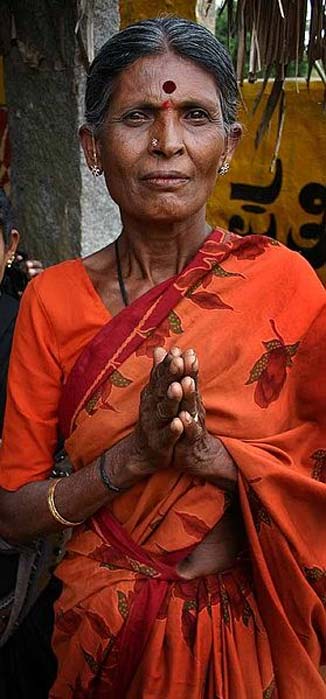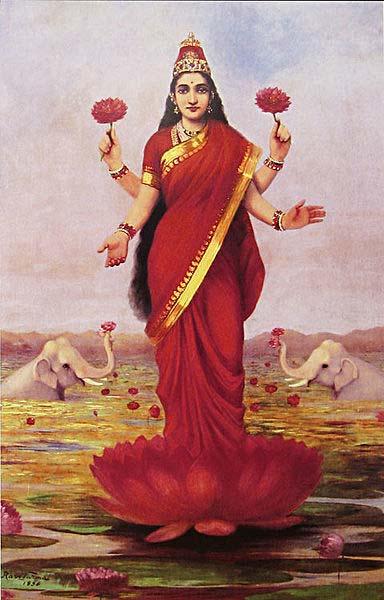
Bindi: Investigating the True Meaning Behind the Hindu Forehead Dot
A distinct dot is a popular forehead decoration worn mainly in South Asia - especially in India, Bangladesh, Nepal, Sri Lanka, and Mauritius. It is an old Hindu tradition and is known as a bindi, which means “a drop, small particle, and dot.” The word ‘Bindi’ is derived from the Sanskrit word 'bindu' and is associated with a person’s mystical third eye. Although they are rooted in the Hindu tradition, Bindis have transformed over time and have become popular accessories and fashion statements for some people. For example, several Western celebrities have been accused of cultural appropriation for wearing a bindi.
The Traditional Bindi
Traditionally, it is a bright red dot applied to the center of the forehead close to the eyebrows. But bindis can also be other colors with a sign or piece of jewelry worn upon them. Many people associate the red bindi with the ancient practice of offering blood sacrifices to appease the Gods.

A Hindu woman with a red bindi. (Steve Evans/CC BY 2.0)
It is interesting to note that in the ancient Aryan society a bridegroom made a 'tilaka' (long vertical mark) on the bride's forehead as a sign of wedlock. The present practice could be an extension of that tradition. Significantly, when an Indian woman has the misfortune of becoming a widow, she stops wearing the bindi and other decorations associated with married women.
- Bygone Beauty and Body: The Origins of Cosmetics in the Ancient World
- The Diwali Festival of Lights: A Celebration of Freedom and Good Triumphing over Evil
- The Secret Substance Soma: Bringing Human Beings Closer to the Gods

The ritual of applying the Sindoor (a traditional cosmetic powder) as part of a Hindu Indian wedding. (CC BY SA 3.0) Ceasing to wear this (and the red bindi) usually implies widowhood.
The “Sixth Chakra” and its Significance in Indian Culture
The area between the eyebrows is believed to be the sixth chakra, known as the ajna, meaning “command,” and is believed to be the seat of concealed wisdom. Tantric cults believe that during meditation latent energy rises from the base of the spine toward the head and the ajna is the outlet for this potent energy. The red dot between the eyebrows is said to retain energy in the human body and control the various levels of concentration. It is also the central point of the base of creation itself and symbolizes auspiciousness and good fortune.

The goddess Lakshmi also wears the bindi. (Public Domain)
Hindu tradition holds that all people have a third inner eye; the two physical eyes are used for seeing the external world, while the third focuses inward toward God. As such, the red dot signifies piety as well as serving as a constant reminder to keep God at the center of one’s thoughts.

18th Century illustration from Rajasthan depicting the ajna chakra. (Public Domain)
Bindi Symbolism and Bindi Color Meaning
The eye-catching bindi is one of the most visually fascinating of all forms of body decoration. Hindus attach great importance to this ornamental mark between the eyebrows - a spot that has been considered a major nerve point in the human body since ancient times.

A Hindu woman wearing a red bindi. (ellen Reitman/CC BY SA 2.0)
Apart from a red dot being an auspicious sign of marriage, it also is thought to guarantee the social status and sanctity of the institution of marriage. As the Indian bride steps over the threshold of her husband’s home bedecked in glittering dress and ornaments, and wearing the red bindi that is believed to usher in prosperity, it grants her a place as the guardian of the family’s welfare and progeny.
In modern times, however, the bindi’s symbolism is no longer strictly adhered to, and it is largely used as a beauty accessory or a part of women’s fashion. Traditionally, the red dot was made with a paste of turmeric powder and lemon or lime juice, dried in the sun. Now many Hindu women prefer to wear a jewel in its place.

A modern bride. (Prakhar Amba/CC BY 2.0)
The modern dot knows no gender limits either: men as well as women can wear it. Some modern men wear it on auspicious occasions such as for ritual worship or a wedding, on festive occasions, or while embarking on or returning from a voyage or a campaign. In contrast, the tradition of men wearing the tilaka has faded in recent times – now a lot more women than men sport that decoration.

A man wearing a yellow bindi in Bangalore, India. (Victorgrigas/CC BY SA 3.0)
Other changes are seen in some single women wearing black dots, while married women wear red ones. Today, women often wear dots that match the color of their saris too.
- The Allure of Blackened Teeth: A Traditional Japanese Sign of Beauty
- The Hindu sacred texts about human origins
- Swans Fat, Crocodile Dung, and Ashes of Snails: Achieving Beauty in Ancient Rome

Female security guard in Narayangarh, District Chitwan, Nepal wearing a black bindi. (Sigismund von Dobschütz/CC BY SA 3.0)
Controversy and Questions of Cultural (Mis)Appropriation
It takes considerable practice to achieve the perfect round shape by hand, but in modern times (and with changing fashion) women are trying out different shapes and designs. At times, “the red dot” is not a dot at all - but a straight vertical line or an oval, a triangle, or a miniature work of art made with a fine-tipped stick, dusted with gold and silver powder, studded with beads, and encrusted with glittering stones!

A modern decorative bindi. (Drew/CC BY 2.0)
The bindi has also become popular outside South Asia in recent years, and it is often worn as a fashion statement by celebrities and others. Some men and women within traditional bindi-wearing cultures have criticized this act as one of cultural appropriation; but they probably fail to realize that in Western showbiz and consumerist cultures it's all about the money - and unfortunately morals or traditions tend to disappear more rapidly in the name of profit.
This is not to disregard the fact that there is much controversy around who has the right to wear a bindi. The provocative question is approached by writer and law student Vidya Ramachandran, for example, who writes:
“Unfortunately, there’s no simple answer to that question. A number of South Asian women writing on this subject have formulated their own criteria for acceptable usage of the bindi. Aarti Olivia suggests that a non-South Asian may wear a bindi if they are either getting married to a South Asian, or attending an Indian festival or ritual. Meanwhile, recognising the broader cultural significance of the bindi, Reclaim the Bindi suggests that all South Asians, including those who do not have Hindu heritage, may wear the bindi at their own discretion. I find it more useful to use these suggestions as just that — suggestions, or rough guidelines for behaviour, rather than steadfast rules. It is literally impossible to come up with an exhaustive list of acceptable situations for wearing a bindi […]”

Three celebrity women who have created a lot of controversy for wearing a bindi. (Global Cultures)
Like many other practices that have been discussed in the light of cultural rights and cultural appropriation, the answer to who can wear the bindi remains a topic of debate.
Top Image: Close-up of a woman’s eyes and red bindi. Source: IndiaPix /Adobe
References:
Caron, M. (n.d.) Bindis: Their History & Meaning. Available at: http://blog.sivanaspirit.com/bindis-their-history-and-meaning/
Das, S. (2016) Bindi: The Great Indian Forehead Art. Available at: http://hinduism.about.com/od/bindis/a/bindi.htm
Desai, V. (1996) FAQ: What does the red dot on the forehead mean? Available at: http://www.hindunet.org/srh_home/1996_9/msg00176.html
















Comments
<a href="http://www.colt-ledger.com/" rel="nofollow"> colt ledger </a> startup company which has no strong background comes can make you fool.A take a look at on fraud posted through accounting company KPMG global observed “a very massive increase in instances regarding the exploitation of weak inner controls with the aid of fraudsters up from forty nine percent in 2007 to 74 percent in 2011.”
They don’t hurt anyone either. And they help people a lot more than you are willing to admit.
Oh man, You are soooo ignorant I can not find words to describe it. This Hindu stuff is much much older and closer to the truth / god etc, than the Bible which can be labeled as "relatively new" compared to the Vedic texts. Jesus will not save You - only You can save Yourself.
Go and start meditating, then come back a year later and tell how things have changed. Thank You.
these so called rituals save no one :(
Only Jesus Christ saves !